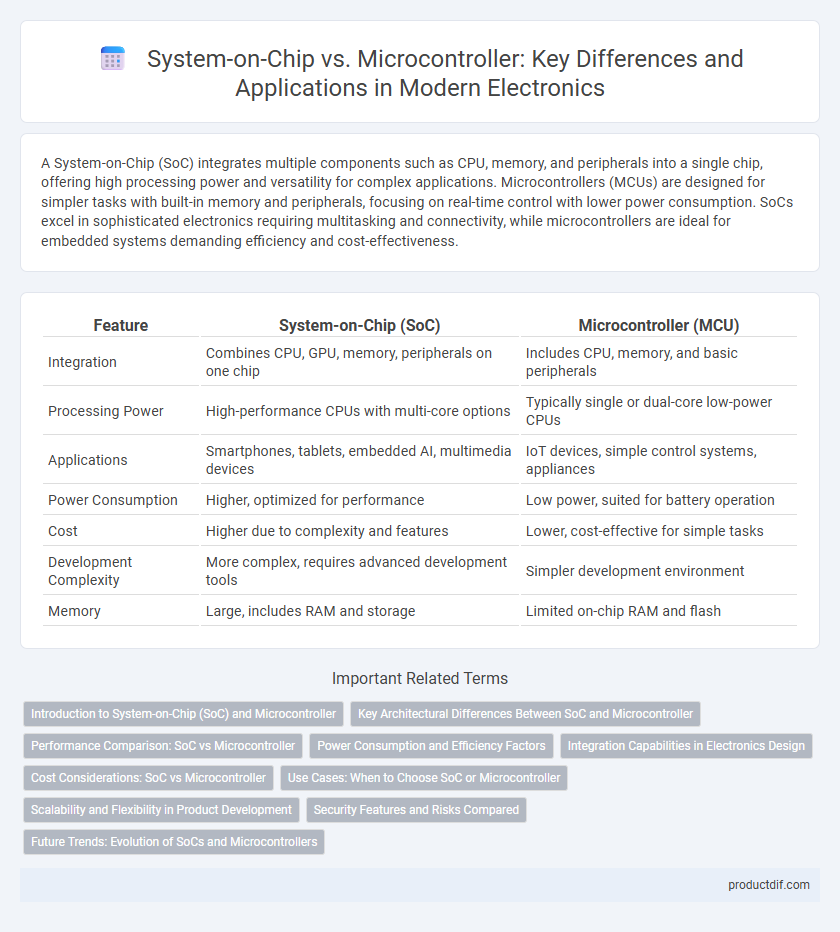A System-on-Chip (SoC) integrates multiple components such as CPU, memory, and peripherals into a single chip, offering high processing power and versatility for complex applications. Microcontrollers (MCUs) are designed for simpler tasks with built-in memory and peripherals, focusing on real-time control with lower power consumption. SoCs excel in sophisticated electronics requiring multitasking and connectivity, while microcontrollers are ideal for embedded systems demanding efficiency and cost-effectiveness.
Table of Comparison
| Feature | System-on-Chip (SoC) | Microcontroller (MCU) |
|---|---|---|
| Integration | Combines CPU, GPU, memory, peripherals on one chip | Includes CPU, memory, and basic peripherals |
| Processing Power | High-performance CPUs with multi-core options | Typically single or dual-core low-power CPUs |
| Applications | Smartphones, tablets, embedded AI, multimedia devices | IoT devices, simple control systems, appliances |
| Power Consumption | Higher, optimized for performance | Low power, suited for battery operation |
| Cost | Higher due to complexity and features | Lower, cost-effective for simple tasks |
| Development Complexity | More complex, requires advanced development tools | Simpler development environment |
| Memory | Large, includes RAM and storage | Limited on-chip RAM and flash |
Introduction to System-on-Chip (SoC) and Microcontroller
System-on-Chip (SoC) integrates multiple components such as CPU, memory, peripherals, and often specialized processing units on a single semiconductor substrate, enabling complex computing tasks in compact devices. Microcontrollers combine a CPU core, memory, and programmable input/output peripherals into one integrated circuit, designed primarily for embedded control applications with real-time constraints. SoCs offer higher performance and versatility for multimedia and networking applications, whereas microcontrollers prioritize low power consumption and cost efficiency for simpler, dedicated control systems.
Key Architectural Differences Between SoC and Microcontroller
System-on-Chip (SoC) integrates multiple components such as CPU cores, memory blocks, input/output peripherals, and communication interfaces onto a single chip, optimizing performance and power consumption for complex applications. Microcontrollers typically feature a simpler architecture with a single CPU, limited memory, and basic peripheral interfaces designed for specific control tasks in embedded systems. The key architectural difference lies in SoCs offering higher integration and scalability, supporting multitasking and advanced processing, while microcontrollers focus on cost-effectiveness and real-time control with minimal system complexity.
Performance Comparison: SoC vs Microcontroller
System-on-Chip (SoC) devices deliver higher performance than traditional microcontrollers by integrating multiple processing cores, advanced GPUs, and specialized accelerators within a single chip, enabling parallel processing and complex computations. Microcontrollers typically operate at lower clock speeds with limited peripheral interfaces and memory, making them suitable for simpler, real-time control tasks. The enhanced computational capability and scalability of SoCs make them ideal for applications requiring intensive data processing, multimedia handling, and connectivity, while microcontrollers excel in cost-sensitive, low-power embedded systems.
Power Consumption and Efficiency Factors
System-on-Chip (SoC) designs typically offer higher power efficiency by integrating multiple components such as CPU, GPU, and memory on a single chip, reducing inter-chip communication energy losses. Microcontrollers generally consume less power during low-processing tasks due to their simpler architectures and lower clock speeds, making them ideal for battery-operated devices. Efficiency depends on workload and application, with SoCs excelling in high-performance scenarios and microcontrollers being optimal for energy-constrained embedded systems.
Integration Capabilities in Electronics Design
System-on-Chip (SoC) solutions integrate multiple functional modules such as CPU cores, memory blocks, analog interfaces, and communication peripherals on a single silicon die, offering enhanced integration capabilities for complex electronics design. Microcontrollers typically combine a CPU with limited on-chip memory and basic peripherals, optimized for specific embedded applications with lower integration demands. SoCs enable higher design efficiency and reduced footprint by consolidating diverse components, while microcontrollers prioritize simplicity and cost-effectiveness in less complex system designs.
Cost Considerations: SoC vs Microcontroller
System-on-Chip (SoC) devices generally have higher initial development costs compared to microcontrollers due to their complex integration of multiple components on a single chip. Microcontrollers offer lower unit costs and are ideal for low to medium volume production, making them cost-effective for simpler applications. SoCs provide long-term cost benefits in mass production by reducing the need for external components and minimizing PCB size, which lowers assembly and material expenses.
Use Cases: When to Choose SoC or Microcontroller
System-on-Chip (SoC) is ideal for complex applications requiring high processing power, integrated peripherals, and multimedia capabilities, commonly found in smartphones, IoT devices, and embedded AI systems. Microcontrollers excel in real-time control tasks, low power consumption environments, and cost-sensitive applications such as home automation, industrial control, and simple sensor management. Selecting between SoC and microcontroller depends on project complexity, processing needs, power budget, and integration level.
Scalability and Flexibility in Product Development
System-on-Chip (SoC) platforms offer superior scalability by integrating multiple components such as processors, memory, and peripherals on a single chip, enabling complex and customizable applications in electronics. Microcontrollers provide flexibility with simpler architecture, making them ideal for low-power, cost-sensitive projects requiring quick development cycles and straightforward tasks. Choosing between SoC and microcontroller depends on the required processing power, design complexity, and the need for future scalability in product development.
Security Features and Risks Compared
System-on-Chip (SoC) integrates multiple components including processors, memory, and peripherals on a single chip, offering enhanced security features such as hardware encryption engines, secure boot, and trusted execution environments, which provide robust protection against unauthorized access and tampering. Microcontrollers typically have more limited security capabilities, often relying on software-based protections and basic hardware security modules, making them more vulnerable to attacks like code injection and side-channel exploits. The advanced security architecture of SoCs reduces risks in complex applications, while microcontrollers require additional external security measures to mitigate vulnerabilities.
Future Trends: Evolution of SoCs and Microcontrollers
Future trends in Electronics highlight the increasing integration of System-on-Chip (SoC) designs, combining CPU, GPU, memory, and specialized accelerators into single chips for enhanced performance and power efficiency. Microcontrollers continue evolving with advanced security features, AI capabilities, and real-time processing to meet growing demands in IoT and edge computing. The convergence of SoC complexity and microcontroller simplicity paves the way for versatile, scalable solutions in embedded systems and smart devices.
System-on-Chip vs Microcontroller Infographic

 productdif.com
productdif.com